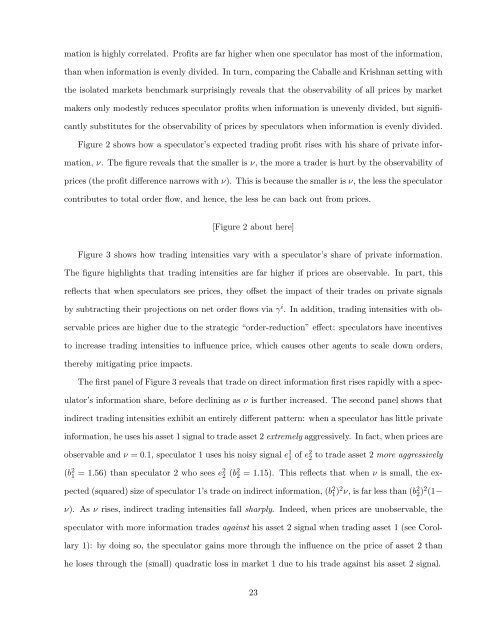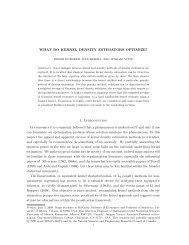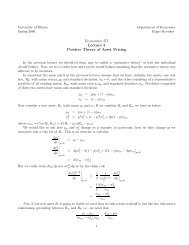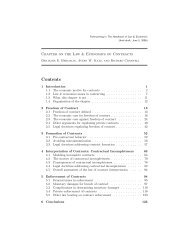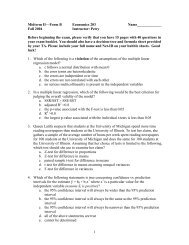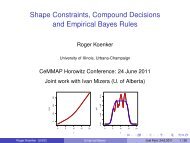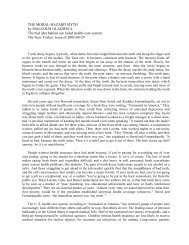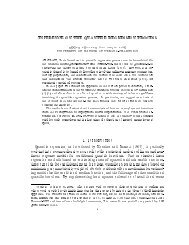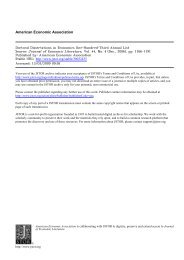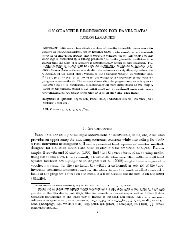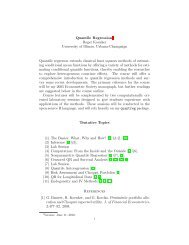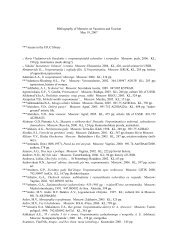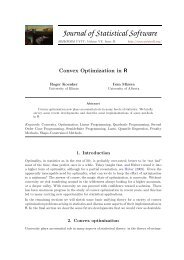Cross-Asset Speculation in Stock Markets∗ - Econometrics at Illinois ...
Cross-Asset Speculation in Stock Markets∗ - Econometrics at Illinois ...
Cross-Asset Speculation in Stock Markets∗ - Econometrics at Illinois ...
Create successful ePaper yourself
Turn your PDF publications into a flip-book with our unique Google optimized e-Paper software.
m<strong>at</strong>ion is highly correl<strong>at</strong>ed. Profits are far higher when one specul<strong>at</strong>or has most of the <strong>in</strong>form<strong>at</strong>ion,than when <strong>in</strong>form<strong>at</strong>ion is evenly divided. In turn, compar<strong>in</strong>g the Caballe and Krishnan sett<strong>in</strong>g withthe isol<strong>at</strong>ed markets benchmark surpris<strong>in</strong>gly reveals th<strong>at</strong> the observability of all prices by marketmakers only modestly reduces specul<strong>at</strong>or profits when <strong>in</strong>form<strong>at</strong>ion is unevenly divided, but significantlysubstitutes for the observability of prices by specul<strong>at</strong>ors when <strong>in</strong>form<strong>at</strong>ion is evenly divided.Figure 2 shows how a specul<strong>at</strong>or’s expected trad<strong>in</strong>g profit rises with his share of priv<strong>at</strong>e <strong>in</strong>form<strong>at</strong>ion,ν. The figure reveals th<strong>at</strong> the smaller is ν, the more a trader is hurt by the observability ofprices (the profit difference narrows with ν). This is because the smaller is ν, the less the specul<strong>at</strong>orcontributes to total order flow, and hence, the less he can back out from prices.[Figure 2 about here]Figure 3 shows how trad<strong>in</strong>g <strong>in</strong>tensities vary with a specul<strong>at</strong>or’s share of priv<strong>at</strong>e <strong>in</strong>form<strong>at</strong>ion.The figure highlights th<strong>at</strong> trad<strong>in</strong>g <strong>in</strong>tensities are far higher if prices are observable. In part, thisreflects th<strong>at</strong> when specul<strong>at</strong>ors see prices, they offset the impact of their trades on priv<strong>at</strong>e signalsby subtract<strong>in</strong>g their projections on net order flows via γ i . In addition, trad<strong>in</strong>g <strong>in</strong>tensities with observableprices are higher due to the str<strong>at</strong>egic “order-reduction” effect: specul<strong>at</strong>ors have <strong>in</strong>centivesto <strong>in</strong>crease trad<strong>in</strong>g <strong>in</strong>tensities to <strong>in</strong>fluence price, which causes other agents to scale down orders,thereby mitig<strong>at</strong><strong>in</strong>g price impacts.The first panel of Figure 3 reveals th<strong>at</strong> trade on direct <strong>in</strong>form<strong>at</strong>ion first rises rapidly with a specul<strong>at</strong>or’s<strong>in</strong>form<strong>at</strong>ion share, before decl<strong>in</strong><strong>in</strong>g as ν is further <strong>in</strong>creased. The second panel shows th<strong>at</strong><strong>in</strong>direct trad<strong>in</strong>g <strong>in</strong>tensities exhibit an entirely different p<strong>at</strong>tern: when a specul<strong>at</strong>or has little priv<strong>at</strong>e<strong>in</strong>form<strong>at</strong>ion, he uses his asset 1 signal to trade asset 2 extremely aggressively. In fact, when prices areobservable and ν = 0.1, specul<strong>at</strong>or 1 uses his noisy signal e 1 1 of e2 2 to trade asset 2 more aggressively(b 2 1 = 1.56) than specul<strong>at</strong>or 2 who sees e2 2 (b2 2= 1.15). This reflects th<strong>at</strong> when ν is small, the expected(squared) size of specul<strong>at</strong>or 1’s trade on <strong>in</strong>direct <strong>in</strong>form<strong>at</strong>ion, (b 2 1 )2 ν, is far less than (b 2 2 )2 (1−ν). As ν rises, <strong>in</strong>direct trad<strong>in</strong>g <strong>in</strong>tensities fall sharply. Indeed, when prices are unobservable, thespecul<strong>at</strong>or with more <strong>in</strong>form<strong>at</strong>ion trades aga<strong>in</strong>st his asset 2 signal when trad<strong>in</strong>g asset 1 (see Corollary1): by do<strong>in</strong>g so, the specul<strong>at</strong>or ga<strong>in</strong>s more through the <strong>in</strong>fluence on the price of asset 2 thanhe loses through the (small) quadr<strong>at</strong>ic loss <strong>in</strong> market 1 due to his trade aga<strong>in</strong>st his asset 2 signal.23


